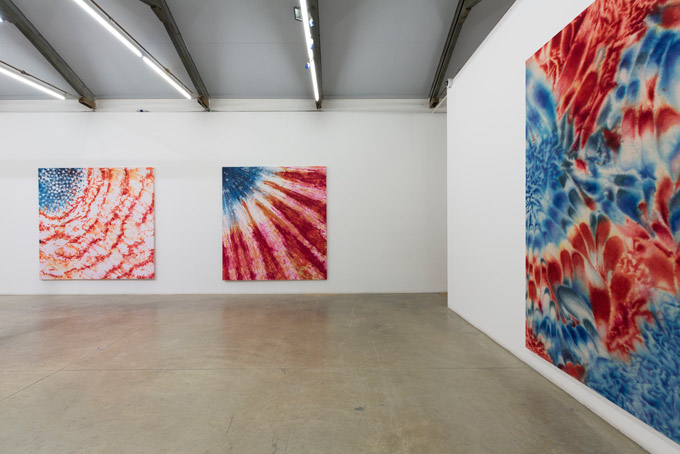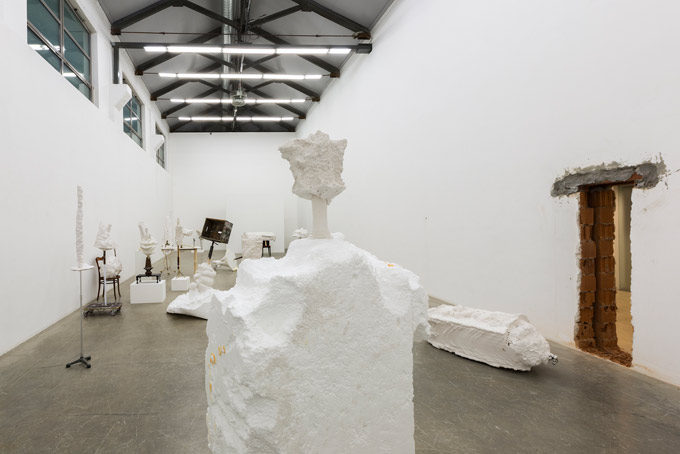The first thing you come upon walking through the warehouse-like entrance of Massimo de Carlo Gallery, is a white panel wall that it appears a kid just scribbled some letters on. You might feel a bit confused, but you actually just need to look closer. At second glance, you can actually catch the titles of two shows, and the artists’ names in the childish lettering. Someone has blithely doodled with a pencil over the words, and you finally recognize Gelitin’s playful style.
This time, the leading contemporary art gallery in Milan chose to feature two solo exhibitions—displayed over the three floors of its building. While their titles’ letters are ironically mixed up on the introductory panel, the shows themselves have been split among the different spaces inside the gallery.
You enter Gelitin’s world first—and if you happen to be familiar with the Austrian artists’ research, you will know you might expect something really odd to happen on these occasions. And yet, what you initially see is a great series of white classical sculptures displayed all over the space. After getting closer to them, you see they are all made of plaster, along with different materials depending on each shape (abstract, organic, simple, complex…) It is in walking through a passage Gelitin created by digging through a gallery wall that one is able to grasp what this sculpture series belongs to.
The Wien-based artist collective, created in 1990 to look back at the history of European performance, exhibited the outcome of Gelatin’s striking six-day performance featured at 21er Haus Museum of Contemporary Art in Wien last summer. A huge, monumental cube of Styrofoam, placed in the middle of the Museum’s hall, has been progressively eroded and perforated by Gelitin with different tools. All around, some musicians, some artists’ friends, and the public itself contributed to create a surreal atmosphere. They looked like primitive men working at a marble quarry: and yet, they didn’t have the sky above them, but a modern building and a group of odd people swelling, moving, playing, and dreaming around them. This theatrical labor of excavation, erosion, and perforation of the polystyrene created a number of empty spaces that the artists filled with plaster. It was probably in this precise moment that determination and chance bump into each other to generate something new. You can see all of this in the video Gelitin LOCH, shot by Angela Christlieb as a document of the Wien performance. The work’s concept focuses on the idea of BUCO (hole, in Italian)—a negative space, a philosophical bubble of meditation from which positive shapes can be derived. And while you’re trying to concentrate on Gelitin’s perfomance playing on the flatscreen in front of you, please pay attention when having a seat, not on a common bench, of course, but the collective’s Untitled (2013). A weird noise might embarrass you if you’re not alone in the space.

Piotr Uklański, “Red, White and Blue,” Installation at View Massimo De Carlo, Milano, 2014.
Photo Credit: Roberto Marossi. Courtesy of Massimo De Carlo, Milano/London.
Before moving to the third floor to see the last pieces by Gelitin, you’ll meet the second, great solo show presented in the space, Piotr Uklański’s “Red, White and Blue.” The visionary world you come across looks quite the opposite: no more pure white sculptural michelangiolesque shapes, but a series of two-dimensional colorflul canvases, portraing the U.S. flag in different interpretations.
Actually, the shows path starts with a cute, innocent portrait of the Polish artist’s daughter in her blonde childish braids. She is something that deeply changed Uklański’s life; the life of an immigrant from Eastern Europe to New York City. He decided to examine his own history—mostly, the inner one, through the colors of a national ideology, which deeply marked his own history.
In this series, the American flag becomes a visionary journey on the threshold of abstraction. The colors—primarily red, white and blue—never quite resemble themselves, but play with their own palette and get closer to exotic shapes and abstract patterns. Each painting, realized on cotton and mounted on a large-size canvas, presents an inner world where the USA imagery blurs into dramatic drawings, until you’re not sure anymore of what it really means to you.
Finally, you reach the third small floor of the exhibition space with your eyes full of colors. And colors, again, are what you come across in the three-dimensional drawings by Gelitin. After questioning the possibilities of sculpture in the most conceptual and practical way, the artistic collective also seems to investigate the boundaries between drawing and objects. In this series, some crinkled paper sheets stick out from the wall itself, unveiling worlds full of color and tiny figures. Similar to some dripping paintings, they actually feature some funny ensemble, helpful to recall the typical characters throughout Gelitin’s work.
By Barbara Meneghel
























